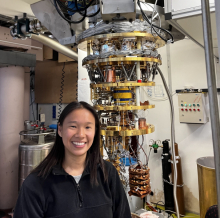
Major:
Mentor(s):
Faculty Sponsor(s):
Faculty Sponsor's Department(s):
Project Title:
Project Description:
The realization of quantum optomechanical Stimulated Ramann Adiabatic Passage (STIRAP)
requires the exploration and fabrication of many different materials and devices. Specifically, we
would like to create photonic devices with high-quality capabilities at sub-mK temperatures. Due
to their inability to retain heat, superfluids are a desirable material to include in the fabrication of
these devices. First, a number of different designs of photonic devices must be tested via
computer simulations in COMSOL in order to find optimal parameters for our purposes. Moving
toward simulations that resemble what we would ultimately like to fabricate and test
experimentally, the equations required to simulate superfluids in COMSOL’s Equation Based
Modeling feature were derived and implemented. Aside from the delicate fabrication process,
another important part of quantum STIRAP is the detection of photon-phonon entangled pairs,
for which a filter system is being developed at Universiteit Leiden in the Netherlands. The
system is composed of eight mirrors that form four filter cavities designed to detect a single
photon from the interaction between the pump light and a modulating membrane. Holding each
of the four filter cavities at the resonant frequency of the reference cavity simultaneously
requires precision within the order of a few picometers, for which a controller, called a ‘lock
box’ is needed. Design and creation of these lock boxes was executed in the Kamerlingh Onnes
National Laboratorium at Universiteit Leiden, and a neural network developed by Kellan
Colburn (another collaborator of the Bouwmeester Group) was used to guide the locking. It was
found that the box is able to lock fast and precisely, with a low signal to noise ratio coming into
and out of the system.
